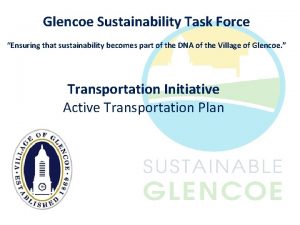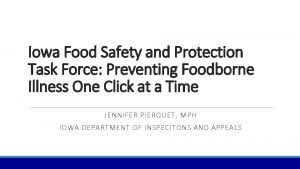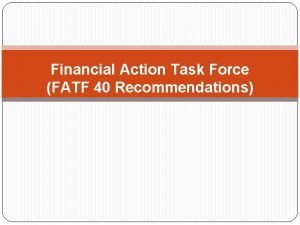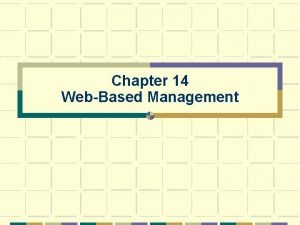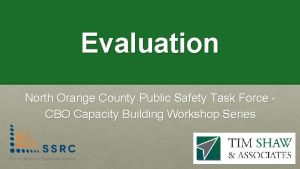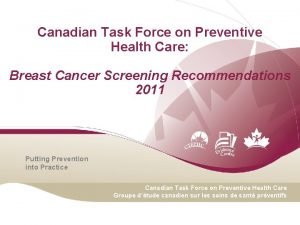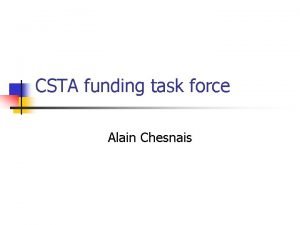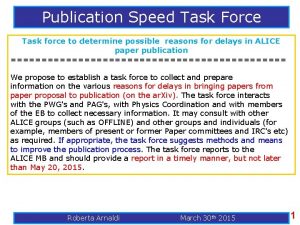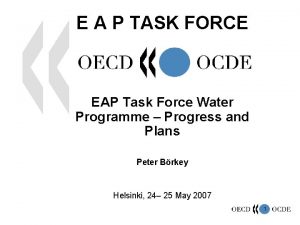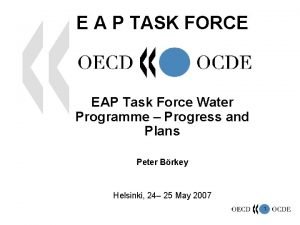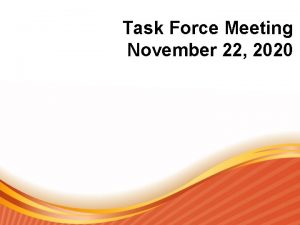Increasing Screening in the Private Sector Task Force
























- Slides: 24

Increasing Screening in the Private Sector Task Force Gale R Burstein, MD, MPH, FAAP Medical Director Epidemiology and Surveillance and STD & TB Control Erie County Department of Health Buffalo, New York November 1, 2006

Adolescent STI Services: Challenges and Opportunities ¢ Health systems level ¢ Provider ¢ Patient level (adolescent) level

Adolescent STI Services: Challenges and Opportunities Systems Level

Systems Level: Opportunities ¢ New opportunities for routine non-invasive STI testing l ¢ Urine nucleic acid amplification tests (NAATs) for STIs New Pap smear guidelines – 1 st Pap at 3 years after start sex or at 21 years old ¢ Chlamydia testing sexually active 16 -25 year old females is HEDIS measure

Systems Level: Opportunities ¢ All 50 states and D. C. have laws allowing minors right to consent for STI testing and treatment l 30 states include HIV testing and treatment in STI services to which minors may consent ¢ Federal funding for STI testing and care

New York State Minors Reproductive Rights Law ¢A minor (person <18 yrs), may be counseled, tested and treated for STIs without a parent or guardian's consent, as long as the minor understands the risks and benefits of the proposed and alternative treatments. ¢ “Information about STIs cannot be released to parents or guardians without the patient’s permission. ”

Systems Level: Challenges NYS Insurance Law Section 3234 ¢ Mandates that health insurance companies provide to their members/subscribers an explanation of benefits (EOB) statement following a filed claim under any policy providing hospital or medical expense benefits (Circular Letter No. 7, March 24, 2005). ¢ EOB must contain information about the date, cost and scope of health care services received. l no exception relating to the age of the member receiving the service or the nature of that service.

Systems Level: Challenges $$$$ ¢ Adolescent age group most likely to be uninsured ¢ Copayments may be barrier for youth receiving care ¢ How to bill for “confidential” health care services? l ¢ Explanation of Benefits may result in disclosure to parent Difficult to bill for sexual health services l l More time in visit not reimbursed Cannot bill for “first” pelvic exam

Systems Level: Challenges Access/Availability ¢ Health plans may not offer urine STI NAAT tests ¢ Many providers do not offer STI services ¢ Limited time available for health care visit ¢ Limited provider office hours ¢ Adolescent access to transportation

Adolescent STI Services: Challenges and Opportunities Provider Level

Provider Level: Knowledge ¢ Not aware of non-invasive STI test options l l new urine chlamydia NAATs New Pap test guidelines ¢ Unfamiliar with minors’ rights to consent for STI care ¢ Lack of STI clinical training ¢ Unclear how to bill for confidential STI services

Provider Level: Skill ¢ Many not skilled or comfortable offering confidential sexual health services to adolescents Performing an “atraumatic parentectomy” l Discussing sexual health, including sexual activity information l

Provider Level: Beliefs ¢ Assume that chlamydia is not a health problem in their adolescent patient population ¢ Low priority and lack of time ¢ Perceive inadequate reimbursement and financial disincentives for providing sexual health services

Adolescent STI Services: Challenges and Opportunities Adolescent Patient Level

Patient Level: Knowledge ¢ Teens unaware of need for preventive health care services ¢ Lack of knowledge regarding STIs Most have no symptoms l Usually need a test to identify infection l

Patient Level: Beliefs ¢ Falsely l perceive low STI-risk stigma ¢ Perceive primary care provider does not want to address sexual health needs ¢ Health care is a low priority ¢ Believe cannot receive confidential services

Is this hopeless? ?

Providing Confidential Care for Adolescent Healthcare in Primary Care Settings A Region II Infertility Prevention Project Demonstration Project Partnership with the Foundation for Healthy Living

The Foundation For Health Living (FHL), Albany, NY ¢ Non-profit, 501(c)3 health services and research foundation ¢ Mission to increase and disseminate knowledge about health care and improve health of NYS residents. ¢ Affiliated with Health. Now New York, Inc. l l l Blue Cross Blue Shield subsidiary A leading NYS health plan Serves members from over 53 counties in Upstate NY

Providing Confidentiality for Adolescent Health Care: A Demonstration Project 1) Develop a consensus statement on adolescent confidentiality in health care in private practice settings 2) Develop a set of recommendations for the NYSDOH and NYS Insurance Department to address gaps in adolescent confidentiality in the provision of STI-related care for commercially insured clients in private practice settings.

Providing Confidentiality for Adolescent Health Care Advisory Work Group ¢ Comprised of adolescent health care stakeholders NYSDOH l New York State Insurance Department l health plans l prominent pediatricians l adolescent health physicians l

PCAHC Demonstration Project Objectives ¢ To better understand the need for confidential adolescent health care ¢ Identify barriers to confidential adolescent health care ¢ Review the current legal and regulatory state as it pertains to confidential adolescent health care ¢ Propose a series of recommendations for short and long term solutions to remove barriers ¢ Collate and disseminate findings from proceedings. ¢ Wherever possible, facilitate translation of outcomes and products for use throughout the nation.

PCAHC Demonstration Project Activities ¢ ¢ ¢ ¢ ¢ Create an advisory work group of medical, health and policy experts Identify national experts who will help inform workgroup activities Convene 2 PCAHC meetings Stakeholders will convene meetings with local stakeholders to vet recommendations Review the NYS Reproductive Minor’s Right’s Law Review reproductive health recommendations from professional medical societies, adolescent health providers and advocacy organizations Consider the unique barriers related to the provision of confidential reproductive health services for commercially insured adolescents Assess model provider-patient confidentiality tools across the country Consider educational interventions and materials tailored to health care providers, parents and adolescents

PCAHC Demonstration Project Outcomes ¢ Develop consensus statement on adolescent confidentiality in health care ¢ Provide recommendations to NYSDOH and Insurance Department to address gaps in adolescent confidentiality ¢ Publish and disseminate findings, lessons learned and recommendations, emphasizing both local and national implications. ¢ Conduct assessment among identified health plans to determine if they made or plan to make any changes related to the provision of confidential STD-related care as a result of demonstration project recommendations.
 Public sector strategic management
Public sector strategic management Kuwaitization
Kuwaitization Tanzania private sector foundation
Tanzania private sector foundation Private limited company advantages and disadvantages gcse
Private limited company advantages and disadvantages gcse Tiered task bias task
Tiered task bias task Nwcg s-330
Nwcg s-330 Friendly armor battalion task force symbol jko
Friendly armor battalion task force symbol jko Glencoe sustainability task force
Glencoe sustainability task force React task force
React task force Iowa food safety task force
Iowa food safety task force Fatf40
Fatf40 Green ribbon task force
Green ribbon task force Princeton policy task force
Princeton policy task force Desktop management task force
Desktop management task force Anchor institutions task force
Anchor institutions task force Global harmonization task force
Global harmonization task force Social performance task force
Social performance task force Marketing task force
Marketing task force Combined joint task force horn of africa
Combined joint task force horn of africa North orange county public safety task force
North orange county public safety task force Ctfphc
Ctfphc Enemy symbols army
Enemy symbols army Iowa food protection task force
Iowa food protection task force Apa presidential task force on evidence-based practice
Apa presidential task force on evidence-based practice Internet research task force
Internet research task force







